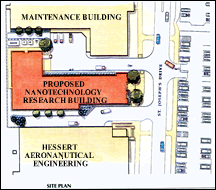
Groundbreaking is scheduled for May 2 on the north side of the University of Notre Dame campus for a new research laboratory that will support theCollegeofEngineerings work in biomedical engineering.
The 25,000-square-foot building will be located between the Hessert Laboratory for Aerospace Research and theMaintenanceBuildingand will be completed in summer 2006. The structures $8.3 million cost is funded by congressional budget mandates and administered by the U.S. Department of Energy, says Robert Cunningham, director of budgets and operations in the College of Engineering.
The facility will house the work of a multidisciplinary team studying biomechanics and biomaterials in orthopedics. The group is composed of faculty from the Department of Aerospace and Mechanical Engineering who apply their understanding of mechanics, materials and design to biology, especially the human skeletal system.
For example, researchers are investigating noninvasive methods of detecting and visualizing microscopic damage that occurs in bone tissue using contrast agents for micro-computed tomography.
Ryan K. Roeder, assistant professor and principal investigator on the team, is looking into the accumulation of microdamage with activity, aging and disease that can result in bone fractures. People undergoing intense physical activity, such as athletes and military recruits, experience stress fractures; at the other end of the spectrum, the elderly experience fractures as a result of fragility.
Unfortunately, physicians do not currently have the means to assess microdamage, Roeder said.In the long term, we hope that our research might change that. In the short term, noninvasive methods for measuring microdamage in bone will certainly enable researchers to better understand the effects of microdamage on bone strength and fracture risk.
This project is supported by the National Institutes of Health.
The group also collaborates with the local orthopedics industry, located in nearbyWarsaw,Ind., on a variety of projects. Glen Niebur, who partners with Roeder on the bone tissue project, is working withDePuy Orthopaedics, a Johnson&Johnson Co., to develop scaffolds that hold engineered tissue onto traditional orthopedic implants. Steve Schmid and Jim Mason have led a collaboration with Zimmer Inc., aimed at creating less invasive surgical procedures for the repair of hip and vertebral fractures. The group also is working to develop new orthopedic implants and synthetic bone substitutes that, when introduced into the body, respond mechanically and biologically like natural bone.
The groups research facilities include a biomaterials processing and characterization lab, design automation lab, nano-mechanical characterization and tribology lab, solid mechanics lab, and surface science lab.
All currently are squeezed into Fitzpatrick Hall of Engineering, Cunningham said. The new facility will provide the infrastructure required to support the groups work, as well as active graduate and undergraduate research experiences.
TopicID: 10922